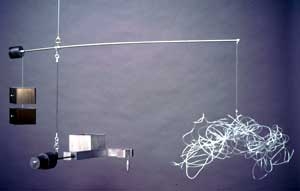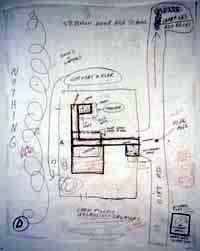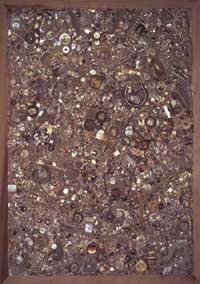Feature: Reviews
Mike Kelley
- Metro Pictures
- Chelsea, New York
- November 2 - December 7, 2002
Reversals, Recyclings, Completions, and Late Additions
Hazy Memories
Secret fantasies, hidden fears, and garbled childhood memories are the focus of the Los Angeles-based Mike Kelley’s latest New York exhibition, entitled Reversals, Recyclings, Completions, and Late Additions. Housed in Chelsea’s Metro Pictures, much of the exhibition centers on Kelley’s obsessive and often amusing dredging up of what he jokingly deems “repressed” memories of his school days.
Kelley gives form to his “memories” with an impressive variety of mediums. From the ceiling of the gallery’s main room hang six aluminum and steel mobiles, each one representing a different school that Kelley attended as a child. The interconnected metal blocks and frames composing these sculptures resemble architectural models or drawings, yet they lack the logic of a blueprint or scale model. Instead, they sprawl across multiple planes, attached with varying lengths of airline cable to steel poles that hang perpendicularly to the gallery ceiling and floor. The different parts of the mobiles balance improbably with one another. For instance, in Repressed Spatial Relationships Rendered as Fluid, No. 3: Reconfiguration of Wayne High into the Ritual Presentation Arena of the Educational Complex (2002), Kelley has somehow balanced a mass of heavy frames and blocks with a single (and inexplicable) ceramic ear of corn. In a sculpture representing Stevenson Junior High School, he pairs a lightweight tangle of wire with eight or nine solid blocks. As I wove my way through the gallery, I imagined that the slightest touch might throw these sculptures out of their seemingly precarious equilibrium and set them swinging to and fro across the gallery. Yet the six Repressed Spatial Relationships mobiles are frozen in space, perfectly still. That Kelley has constructed these memories with such care and precision betrays (intentionally, no doubt) the deliberateness with which he has recalled these supposedly repressed spaces.
The architectural theme continues in the room beyond with Kelley’s 2002 Continuous Screening of Bob Clark’s Film “Porky’s” (1981), the Soundtrack of Which Has Been Replaced with Morton Subotnik’s Electronic Composition “The Wild Bull,” and Presented in the Secret Sub-Basement of the Gymnasium Locker Room. (whew!). Here Kelley has built a maze-like space reminiscent of a set of office cubicles and equipped with desks, chairs, and drafting tables. The walls of this maze are plastered with floorplans and photographs of blocky and depressing school buildings and pictures of classrooms and students. Occasionally a sexually explicit cartoon, the type one might find in a high school boys’ bathroom, punctuates the blueprint monotony. In a semi-hidden corner, Kelley has mounted an intercom that periodically emits high-pitched squeals and squawks - quite appropriate for a gym locker room. Surrounded by high walls and assaulted with electronically generated noise, one feels almost trapped inside Continuous Screening. Adding to the sense of imprisonment are the repetitious architectural renderings, whose neatly ruled ink lines gradually began to remind me of prison bars. Kelley’s elaborate comparison of educational institution to prison could not have been better expressed.
Upstairs, Kelley carries his architectural memories obsession even further, with six framed floorplans representing fantastical counterparts to the drawings downstairs. Scrawled on large sheets of butcher paper with markers, chalk, and paint, these drawings include labels that a cynical seventh-grader might well have used if asked to draw his school building. St. Mary’s Elementary School and Church, for instance, includes a secret room underneath the sacristy, a room labeled “rats killed,” and a series of confessionals marked “the ultimate horror.” Directly to the right of St. Mary’s hangs Kelley’s floorplan of John Glenn High School, in which the scribble “repressed horror-of-horrors” across the school gym recalls the prisonlike complex downstairs.
A second and less pronounced theme in Kelley’s exhibition is that of memory formation or, rather, how material objects become associated with personal and cultural histories. He articulates this question through several large rectangular pieces that he calls Memory Ware Flats (2001). Slathered with tile grout and then covered with beads, buttons, brooches, watches, keys, and other small items, these flats turn discarded personal effects into works of art. Examining the Memory Ware pieces up close, one begins to notice an eerie individuality, almost personality, latent in the hundreds of cast-off items. I found myself asking questions. Who did the gold watch belong to? Who on earth would ever have worn such a tacky pin? Is that braille that’s embossed on the big silver pin? Did it belong to a blind person? Is that an early Gay Pride pin over there, behind the I Love My Teacher keychain? Each object seems to stand in for its previous owner.
Kelley further explores the tendency to personify objects with two large sculptures made of black velvet mounted on wood panels and decorated with faux gemstones. One of these sculptures, shaped like a blotch of spilled ink, has been personified as a googly-eyed dog. The second piece, though similarly shaped, is called Free Gesture Frozen, Yet Refusing to Submit to Personification (2002), a light-hearted title that conjures up images of an artist desperately seeking to endow his free-form squiggle with some kind of personality.
The lighthearted quality of most of Kelley’s works is really what keeps his Metro Pictures exhibition from becoming weighted down by its cerebral aspects. While Kelley uses his art to pose difficult questions about the nature of social institutions, personal identities, and human memory, he does so without conveying any sense of self-importance. Instead, Reversals, Recyclings, Completions, and Late Additions tosses ideas and questions at gallerygoers with an endearing playfulness and flippancy.
Reversals, Recyclings, Completions, and Late Additions is on view at Metro Pictures, 519 West 24th Street, New York, NY. For more information call (212) 206-7100 or e-mail gallery@metropictures.com.



